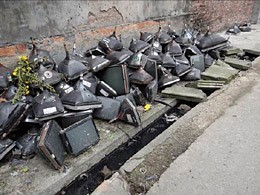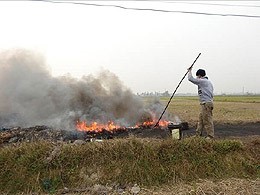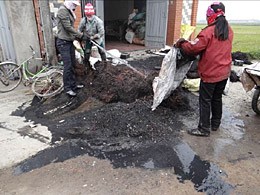- Waste management in Japan
- Circular economy in Japan
- Waste management in Asia
- Disaster waste management
E-waste Recycling and Movement of Hazardous Chemical Substances
Recycling of E-waste
Recycling of waste electrical and electronic equipment (WEEE or E-waste) aims to recover useful resources such as metals (e.g. iron and copper), minor metals and plastics from the waste (see our articles on urban mines and recycling in the January 26, 2009 issue [in Japanese] and in the June 8, 2009 issue [in Japanese]). The E-waste contains useful resource materials in higher concentrations than natural ores do. These materials in E-waste are also of high quality as they have already gone through proper processing. For these reasons, in Japan, both the government and private sector have been promoting appropriate E-waste recycling, and they are expected to continue this effort. The appropriate E-waste recycling not only enables effective recovery of useful resources but also contributes to protecting the natural environment as it reduces the amount of landfill waste and new extraction of natural ores. These reductions can lead to less consumptions of energy and resources, and to less emissions of carbon dioxide (CO2).
Inappropriate recycling and hazardous chemical substance problem
In the current situation, however, inappropriate E-waste recycling operations are also conducted unfortunately. According to the Ministry of the Environment of Japan, some E-waste items are collected illegally by unauthorized operators and processed into scraps in Japan, and then exported abroad, or exported as "reusable" items. This situation has been causing environmental pollutions overseas.
In view of this exportation of the E-waste and scraps from Japan to developing countries in Asia, our research team in the Center for Material Cycles and Waste Management Research has been investigating the status of inappropriate E-waste recycling and its impact on the surrounding environment in these countries (see our article "Toward Appropriate Management of Materials with Hazard and Resource Potential" in the August 2011 issue [in Japanese]). While it is difficult to quantify the correlation between the E-waste exports from Japan and the environmental pollution in these Asian countries, our research aims to contribute to improving or solving the problems related to E-waste recycling in the countries that have close relations with Japan. To date, our team conducted surveys on the status of E-waste recycling in Thailand, Philippines, Indonesia and Vietnam, and revealed the state of chemical exposure of recycling workers in these countries (see our article "Investigating soil and dust of E-waste recycling sites" in the December 2011 issue [in Japanese]). The following paragraphs introduce our field survey in Vietnam which was being carried out at the time of this writing in January 2015.
An E-waste recycling village in Vietnam
Back in January 2011, we confirmed the presence of a recycling village in suburban Hanoi in northern Vietnam, and started the multi-year field survey there in January 2012 in collaboration with researchers of Ehime University and Vietnam National University (VNU)-University of Science, Hanoi, and local residents. E-waste recycling has been a main industry in the village in addition to rice cultivation. The village had population of about 1,000 (about 250 households) in 2012 that has increased to about 3,000 in 2015. Facilities used for E-waste recycling vary in size, and some operate throughout the year while others operate only in between the two rice cultivation seasons. The E-waste recycling appears to have taken root as an activity from which villagers earn their living.
Our interview survey with the villagers revealed that the recycling of E-waste items such as personal computers, TVs, video players and mobile phones started around 2000. E-waste recycling activities such as collection, storage and dismantling of these items had been conducted in this village in order for the villagers to separately collect reusable materials such as plastics and metals or to retrieve copper through open burning of electrical cables. The recycled metals and plastics were reported to be not only reused domestically in Vietnam, but also exported to China. The survey results indicated that the cases of open burning of electrical cables for copper retrieval increased in this village during the period when demand for copper increased in China. These findings confirmed that the E-waste recycling operations in a country is highly influenced by the demand of its export destination countries for the recycled materials. During our field survey, we noticed that some E-waste items had Japanese labels, which suggested a link between Japan and the problems associated with E-waste recycling in developing Asian countries.
Recycling processes and chemical pollution
The field survey in the recycling village was conducted in January 2012, January 2013 and January 2014. We targeted a residential district and the surrounding rice paddies with a total land area of 3.0 km by 1.2 km in order to specifically investigate the impact of E-waste recycling on the surrounding environment. Surface soil samples were collected from various locations including footpaths in rice paddies, sites near E-waste dismantling facilities, and open-burning sites where electrical cables were burned. Sediment samples were taken at several points both upstream and downstream of the dismantling facilities along a river flowing through the center of the recycling village. The collected samples were analyzed and evaluated.
Our results showed that the samples from the points near dismantling facilities and open-burning sites contained high concentrations of chemical substances which we anticipate were derived from E-waste: lead contained in solder and cathode ray tube (CRT) glasses; copper used in electrical cables; cadmium and manganese contained in batteries; tin used in liquid crystal display (LCD) panels; flame retardants and antimony; and dioxin-like compounds generated by open-burning.

In particular, the samples from the open-air storage sites of partially dismantled E-waste items demonstrated high concentrations of relevant chemical substances. For example, a high concentration of lead was detected in the samples from open storage sites of dismantled CRT glasses (Photo 1). In addition to CRT glasses, we also spotted electronic circuit boards and TV casings stored outdoors during our field survey. Due to this improper storage condition, chemical substances such as copper, lead and flame retardants were believed to be transferred into the environment either by rainwater runoff or deterioration from these E-waste items. On the other hand, low chemical concentrations were detected near the recycling facilities where no E-waste part was stored outdoors. From these analysis results, we inferred that storage condition is an important process to affect chemical pollution around the recycling facilities.
During the field survey, we observed electrical wires and cables being burned outdoors to retrieve copper (Photo 2). We found the trend of high concentrations of dioxin-like compounds and copper within the range of several meters from the open-burning sites. Copper catalyzes formation of dioxin-like compounds, which is well known as de novo synthesis. Our analysis results seemed to be consistent with this theory. By contrast, the analysis results for flame retardants still need to be verified. Even within the same distance range from the open-burning sites, only a limited number of flame retardant types in low concentrations tended to be identified. It is possible that thermal decomposition of these chemical substances might have occurred in the open-burning in the temperature range of about 250-350 ℃. Our survey in January 2013 confirmed that the processes of transporting incineration residues and washing them by water for copper retrieval (Photo 3) contributed to the dispersion and runoff of chemical substances into the surrounding environment. In particular, it became clear that the runoff of many chemical substances (e.g. heavy metals, flame retardants and dioxin-like compounds) from the incineration residues polluted the river. The river sediment samples taken at the points near the open-burning sites in January 2013 exhibited that these hazardous chemical substances increased about tenfold from our previous visit in January 2012.


Toward appropriate recycling
The above-mentioned survey data demonstrated that the chemical substances derived from E-waste products tend to concentrate in and around the recycling sites, and that they do not spread much outside these sites. Some soil samples from the recycling facilities and the open burning sites contained the chemical substances exceeding Vietnam's environmental quality standards for farmland and residential areas. As a next step, a chemical exposure survey is planned to investigate how and under what conditions these chemical pollutions may affect the lives of local residents. Our past survey results and findings have been shared with local collaborators and authorities through the workshops that we organized in January 2013 and January 2014 to advocate appropriate E-waste recycling in the target area. We will continue to share these information with them in the future.
For more information
- Uchida N., Matsukami H., Someya M., Tue N.M., Tuyen L.H., Viet P.H., Takahashi S., Tanabe S., Suzuki G. (2018) Hazardous metals emissions from e-waste-processing sites in a village in northern Vietnam. Emerging Contaminants, 4(1), 11 - 21
- Matsukami H., Suzuki G., Someya M., Uchida N., Tue N.M., Tuyen L.H., Viet P.H., Takahashi S., Tanabe S., Takigami H. (2017) Concentrations of polybrominated diphenyl ethers and alternative flame retardants in surface soils and river sediments from an electronic waste-processing area in northern Vietnam, 2012-2014. Chemosphere, 167
- Someya M., Suzuki G., Ionas A.C., Tue N.M., Xu F., Matsukami H., Covaci A., Tuyen L.H., Viet P.H., Takahashi S., Tanabe S., Takigami H. (2016) Occurrence of emerging flame retardants from e-waste recycling activities in the northern part of Vietnam. Emerging Contaminants, 2(2)
- Suzuki G., Someya M., Matsukami H., Tue N.M., Uchida N., Tuyen L.H., Viet P.H., Takahashi S., Tanabe S., Brouwer A., Takigami H. (2016) Comprehensive evaluation of dioxins and dioxin-like compounds in surface soils and river sediments from e-waste-processing sites in a village in northern Vietnam: Heading towards the environmentally sound management of e-waste. Emerging Contaminants, 2(2)


